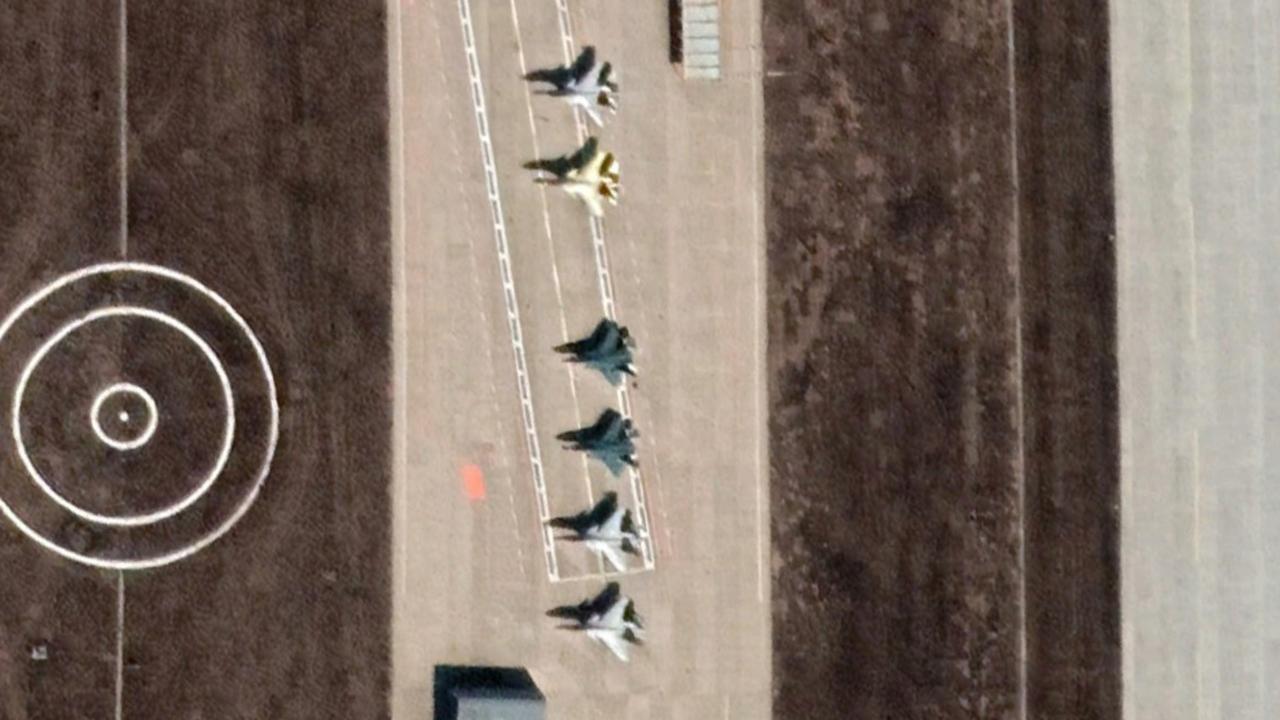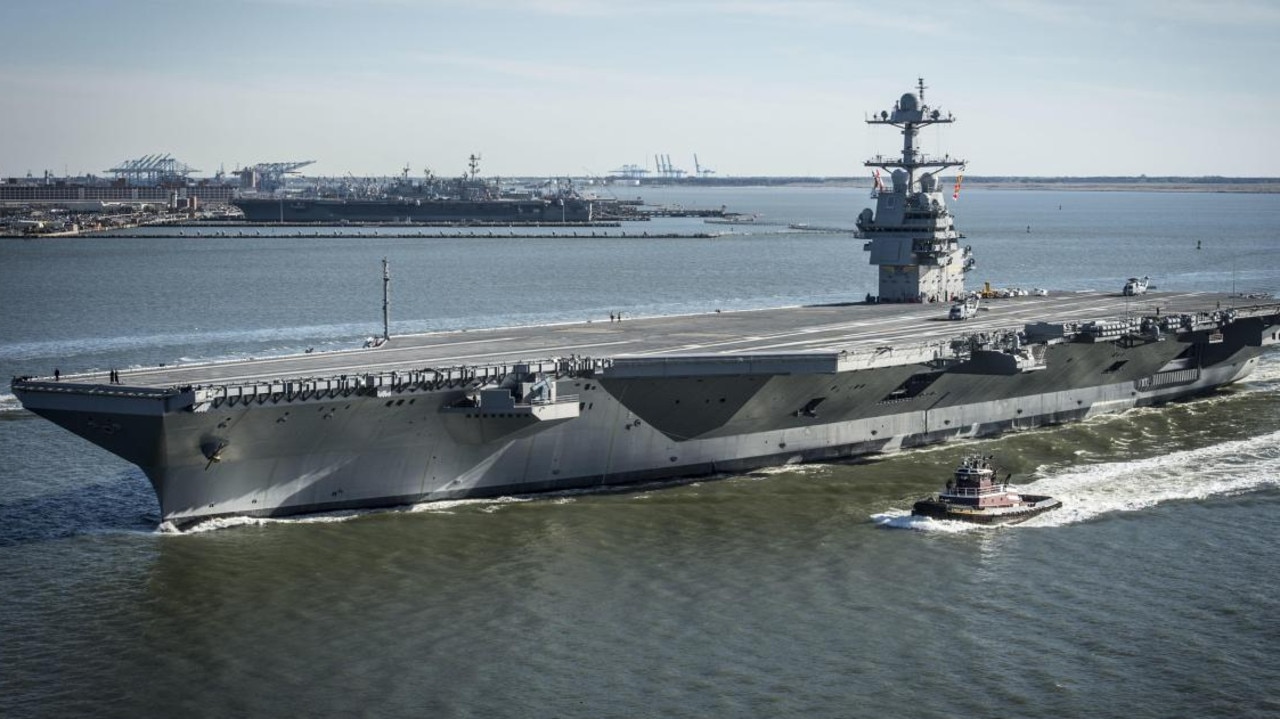Speculation grows over China’s next aircraft carrier
Satellite photos reveal China appears to have changed military tact and its new-found strength is already being applied to the waters around Taiwan and Japan.

Innovation
Don't miss out on the headlines from Innovation. Followed categories will be added to My News.
Beijing’s rush to build military supremacy over Washington is experiencing an unexpected pause. No new aircraft carrier is being assembled on its slipways. Is there a problem? Or a policy change?
China’s shipyards are mass-producing new cruisers, destroyers and assault ships at a rate not seen since World War II. And its new-found naval strength is already being applied to the waters around Japan and Taiwan.
It’s also now a member of an elite club of nations with the economic strength and skill to build and operate a full-blown aircraft carrier complete with catapults capable of firing heavy aircraft into the air at a rapid rate.
So why pause building more of the most powerful ships ever to go to sea? Things may not be going according to Chairman Xi Jinping’s plans.
Hong Kong’s South China Morning Post, now subject to Communist Party controls, says that the finishing touches are still being made to a next-generation nuclear-powered design.
ä¸å›½å…¬å¸ƒäº†å®ƒä»¬çš„航空æ¯èˆ°å®£ä¼ 片
— Inty (@__Inty__) October 9, 2022
China unveils their aircraft carrier propaganda filmpic.twitter.com/IcyZt8PcIe
It quotes the Peoples Liberation Army’s South China Sea Wave social media account as saying the China State Shipbuilding Corporation (CSSC) has been given a deadline. It must have nuclear propulsion technology ready by 2027.
But previous Chinese Communist Party commentary boasted its first nuclear carrier would be ready by 2025. Now, the vast dry-docks built to assemble the 100,000-ton behemoths are building other, smaller ships.
Satellite shot of Liaoning berthed at Qingdao Naval Base, together with two 055 large DDG and a Type 901 large AOR.
— Alex Luck (@AlexLuck9) October 13, 2022
Usual source, "by78"/SDF. pic.twitter.com/av55lys97o
The debate over the effectiveness of the most potent warships of World War II in a modern battle environment has been escalating.
Missiles are far cheaper. And they can now fly further and strike targets with greater precision than ever before. Does that make aircraft carriers irrelevant?
Driving force
China’s latest aircraft carrier, the PLAN Fujian, was launched in June. It’s currently sitting dockside as workers finish its interior fit-out.
It’s almost as big as the latest United States aircraft carrier – the USS Ford. But, like the United Kingdom’s HMS Queen Elizabeth, it’s not nuclear-powered.
China wants nuclear-powered ships for the same reason Australia wants nuclear-powered submarines.
Range. Endurance. Speed.
Removing the need to carry vast quantities of diesel fuel means more food and ammunition can be stored. And that means the vessels don’t have to return to port as often.

China reportedly began work on developing a nuclear-powered ship in 2018. The original idea was to have one in service by 2025. That deadline appears to be slipping.
Chinese sources appear to be conflicting.
It’s argued that diesel-powered ships are better suited to China’s needs. They’re cheaper. They’re less complex and, therefore, faster to build.
But modern aircraft carriers need enormous quantities of electrical power for their catapults, radars and defensive systems. And that would drain diesel fuel tanks even faster.
China already operates nuclear-powered submarines but these power plants would have to be scaled up considerably to be effective aboard a 100,000-ton surface vessel.
Exactly what form China’s next aircraft carrier will take will not be known until its structure begins to be assembled in a dry dock.
And there’s no sign of that yet.
Full steam ahead
China’s determination to build a capable carrier force is not in doubt.
Chinese Communist Party policy declares the desire to own six fully operational carrier battle groups by 2035.
And it’s still working towards that goal.
Recent satellite photos have captured its next-generation carrier fighter sitting among examples of the current J-15 Flying Shark at a naval air base in Liaoning province.
The FC-31 Gyrfalcon is a stealth fighter. It appears to have been given the folding wings, strengthened airframe and arresting hook needed to operate off a flight deck.
And again from Huagdicun ... even if that pilot is waving to a J-15 during take-off, much interesting is what's barely visible on the right corner: The two J-35 mock-ups, which are known since November 2021.
— @Rupprecht_A (@RupprechtDeino) October 13, 2022
(Images via @沉默的山羊 and @央视军事 from Weibo) pic.twitter.com/0aLNH8LUz7
China’s training aircraft carrier, PLAN Liaoning, can carry 26 fighters. Its recently completed stepsister ship PLAN Shandong can hold 32.
None has yet been seen with FC-31s.
Meanwhile, a new two-seat version of the J-15 has also been spotted. A second crew member would give the strike fighter greater electronic warfare capability and the option to control a more diverse range of weapons. But it could also be used as a trainer to accelerate the accreditation of new pilots.
Finally a clearer image of an operational PLAN Naval Aviation J-15S twin-seater with the clearly visible number 46. pic.twitter.com/fxR6thwL4B
— @Rupprecht_A (@RupprechtDeino) August 1, 2022
Chinese state-controlled media has also shown footage of the PLAN’s new KJ-600 fixed-wing early-warning aircraft. Like its very similar-looking US counterpart, it is designed to fly off aircraft carriers to provide expanded radar surveillance over the surrounding area.
These are likely only able to operate off the new PLAN Fujian and future flat-deck carriers.
But they make an aircraft carrier battlegroup all but invulnerable to everything – except wave after wave of hypersonic missiles.
And that would tip the balance of power in both the Pacific and Indian Oceans.
These ships – each carrying as many combat aircraft as Australia owns in total – could linger among shipping lanes for months. Their only restraint would be the need to refuel their powerful protection force of Type 055 cruisers.
And the US has repeatedly demonstrated over the decades the coercive power such a force can project.
Jamie Seidel is a freelance writer | @JamieSeidel
Originally published as Speculation grows over China’s next aircraft carrier









